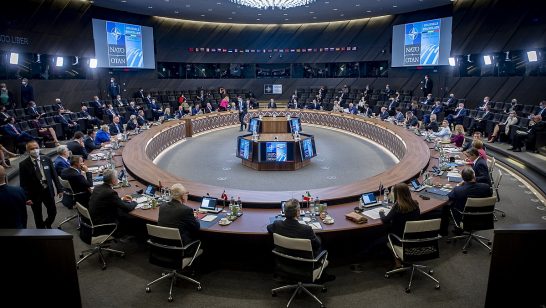
The text below is drawn from a presentation made to an ELN meeting in London in January 2011.
Last August, in anticipation of the Lisbon Summit and the new Strategic Concept, RUSI published a paper that I had the pleasure of coauthoring with my colleague at the Nuclear Threat Initiative (NTI), Isabelle Williams, and Malcolm Chalmers of RUSI.
The title of that paper was, “NATO and Nuclear Weapons: Is a New Consensus Possible?” The premise of our meeting here today is that the question of whether a new consensus on NATO and nuclear weapons is possible remains an open question for NATO.
I personally believe that is the case. I say that based on my reading of the Strategic Concept and NATO Summit Declaration; the promised NATO Deterrence Review; and one other factor: that is, in Washington, the person who appears most committed to the goals outlined in President Obama’s Prague speech is – the President himself.
It is clear that for there to be a new consensus on NATO and Nuclear Weapons, there will need to be political leadership on these issues at very high levels, and not just from President Obama – he will need some help from within NATO, and from outside groups – like the European Leadership Network (ELN). And I would note here that the group statement from some members of the ELN that was issued this past fall was an extremely valuable contribution, one that was widely read in Washington.
In addition to political leadership, if the status quo is going to change, NATO is also going to have to drill down a bit deeper on what I think are three related policy areas over the course of its deterrence review. So let me talk now very briefly about each of those three areas.
I. Nuclear Sharing
The first area includes a number of issues associated with nuclear sharing among allies. As we discussed earlier, NATO’s Strategic Concept commits NATO to the goal of creating the conditions for a world without nuclear weapons – but reconfirms that, as long as there are nuclear weapons in the world, NATO will remain a nuclear Alliance.
The Strategic Concept also states that the supreme guarantee of the security of Allies is provided by the strategic nuclear forces of the Alliance, particularly those of the United States; and that the independent strategic nuclear forces of the United Kingdom and France contribute to the overall deterrence and security of the Allies.
There is no explicit mention of non-strategic nuclear forces (NSNF) in the Concept; however, the Concept states that NATO will ensure the broadest possible participation of Allies in collective defense planning on nuclear roles, in peacetime basing of nuclear forces, and in command, control and consultation arrangements.
Finally, the Concept states that NATO will seek to create the conditions for further reductions in the number of nuclear weapons stationed in Europe in the future.
So against this backdrop, here are some of the options NATO could and should drill down in to on nuclear sharing – beyond the status quo – in order to inform its deterrence review this year.
Let me begin the obvious. With respect to the number of U.S. nuclear weapons deployed in Europe and their locations – NATO should examine options to reduce the U.S. NSNF stockpile, either retaining all existing deployment sites or with a corresponding reduction in deployment sites. With respect to NATO Dual Capable Aircraft (DCA), NATO should examine the continuation of current arrangements for DCA in NATO basing countries, as well as a reduction in NATO countries with dedicated DCA, which would logically coincide with a reduction in deployment sites.
In addition, NATO should go beyond the obvious and examine the ultimate option for consolidation – that is, the removal of all U.S. NSNF from Europe – and explore other means of ensuring that responsibility for NATO nuclear forces is shared amongst member states.
For example, NATO should explore options centered on enhanced consultations and planning arrangements. This could apply to U.S. nuclear forces – non-strategic and strategic – and perhaps UK and French nuclear forces. This could involve commitments between leaders and governments at the highest levels with respect to consultations regarding nuclear weapons-related issues, building on past precedents. This could also involve enhanced or at least more publicized and thus more visible institutional mechanisms for consultations and planning, either within the Nuclear Planning Group (NPG), or perhaps even a new arrangement.
It would seem apparent that enhanced consultations and planning relating to nuclear weapons would be a given for maintaining extended deterrence in a Europe without U.S. NSNF. But beyond the planning function, there are some real choices to be made if all U.S. NSNF are returned to the U.S.
For example, options could be centered on retention of U.S. DCA capability – either inside or outside of Europe – and the capability to redeploy U.S. NSNF to Europe. Here, by definition, the U.S. would retain a stockpile of NSNF and DCA, and at a minimum, some NATO nations would retain the infrastructure to support both U.S. DCA and the storage and security of U.S. NSNF. There could also be European countries that retain a DCA capability – either nationally or as part of a joint operation of some kind.
Options could also be centered on U.S. Strategic Force capabilities, in particular, if NATO concludes that there is little if any relationship to extended deterrence and the ability to redeploy DCA and NSNF in a European context. This could involve, for example, periodic visits of U.S.-based B-52 or B-2 strategic bombers to European bases; or – more on the planning side – the posting of NATO officers to U.S. strategic bomber units.
Finally, options for sharing could also be centered on UK and French nuclear force capabilities, perhaps involving them to a greater degree with their NATO allies.
II. Reassurance
The second area NATO should drill down in to contains a number of issues relating to “reassurance.” NATO could and should examine what are the various means of reassurance – consistent with the new NATO Strategic Concept’s commitment to seek to create the conditions for further NSNF reductions in the future – and the benefits and / or risks involved in these means.
For example, how might the military components of reassurance evolve, including NATO conventional capabilities, NATO non-nuclear contingency planning, and NATO missile defense? How might the political-diplomatic and non-military components of reassurance evolve? What are the specific concerns of various NATO members relating to reassurance, and how might the various components of reassurance – military and non-military – be applied to address their concerns?
III. Russia
The third area NATO needs to drill down in to relates to Russia. I know the topic of the NATO-Russia relationship more broadly is going to be discussed more thematically later in this conference. But the question of how to engage Russia on NSNF goes to the heart of various national perspectives on the posture requirements of NATO’s nuclear policy.
So NATO is going to need to careful consider the issue of next steps in U.S. / NATO-Russia discussions on NSNF – consistent with the direction in the Strategic Concept, that is, to seek Russian agreement to increase transparency on its nuclear weapons in Europe and relocate these weapons away from the territory of NATO members; and also taking into account the disparity with the greater Russian stockpile of short-range nuclear weapons.
For example, what measures could be introduced with Russia on security, transparency and confidence-building that do not require a new treaty or even a formal agreement? This could include a joint threat assessment, a security assessment, recovery exercise, site visit, commitment not to locate NSNF with operational units in the field, or a declaration of the total number of NSNF located in the Euro-Atlantic region.
With respect to further steps relating to U.S. NSNF, how might NATO take into account the disparity with the greater Russian stockpile? Also, and importantly, what form might any joint U.S. / NATO-Russian action take, and how might it be implemented? How should the NATO-Russia Council be used with respect to the issue of NSNF?
There is also the question of what comes next in discussions relating to missile defense and conventional force postures – issues that were briefly touched on by Foreign Minister Ivanov in his speech. In particular, how can the still evolving co-operation among NATO allies in the provision of territorial missile defense best be integrated into the NATO-Russia context in ways that maximize potential political-military benefits vis-à-vis Russia?
And finally, are there ways for NATO and Russia to revitalize and modernize the conventional arms control regime in Europe?
IV. NATO’s Contribution to a Safer and Saner Form of Deterrence
Finally, I would pose one other broader and related issue: that is, is it possible to move from “deterrence” as we know it today – a term that has become synonymous with “nuclear deterrence” in the minds of publics and many leaders – to a new concept of deterrence, with less of an emphasis on the nuclear component that goes far beyond the question of the remaining few hundred U.S. nuclear weapons in Europe? And can NATO contribute positively to a new concept of deterrence as it rethinks extended deterrence in Europe?
The “Shultz-Perry-Kissinger-Nunn” group has written that reliance on nuclear weapons for deterrence is becoming “increasingly hazardous and decreasingly effective.” The current focus of the American four – beginning with a conference at the Hoover Institution last November – is to explore the possibilities for establishing a new concept of deterrence, one that ultimately does not require nuclear weapons or nuclear threats to maintain international peace and security.
That world may not be imminent. But we should start thinking through the relationship of the discussion we are having today in a NATO context to a new concept of deterrence – one with implications that go beyond NATO.
The opinions articulated above represent the views of the author(s), and do not necessarily reflect the position of the European Leadership Network or any of its members. The ELN’s aim is to encourage debates that will help develop Europe’s capacity to address the pressing foreign, defence, and security challenges of our time.


